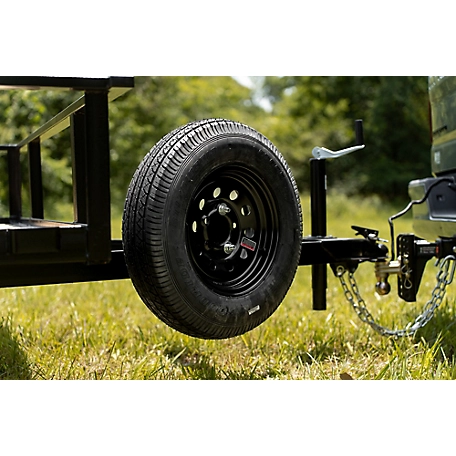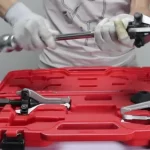Spare Tire Holder for Trailer: Definition, Purpose, and Common Types
A spare tire holder for a trailer is an essential accessory that provides a secure and convenient way to store and transport a spare tire. It is designed to keep the spare tire easily accessible while ensuring it remains firmly in place during travel, preventing potential damage or safety hazards.
The primary purpose of a spare tire holder is to provide a reliable backup option in case of a flat tire or puncture while on the road. Having a spare tire readily available can be a lifesaver, especially when traveling long distances or in remote areas where access to tire services may be limited.
There are several common types of spare tire holders for trailers, each with its own advantages and considerations:
- Mounted Spare Tire Holders: These holders are typically mounted on the rear or side of the trailer, offering a secure and permanent storage solution. Mounted spare tire holders can be either fixed or swingable, allowing for easy access and removal of the spare tire when needed.
- Swing-Away Spare Tire Holders: As the name suggests, these holders are designed to swing away from the trailer, providing easy access to the spare tire. Swing-away holders are often mounted on the rear or side of the trailer and can be locked in place when not in use, ensuring the spare tire remains secure during travel.
- Underbed Spare Tire Holders: These holders are mounted underneath the trailer bed or cargo area, utilizing the available space efficiently. Underbed spare tire holders keep the spare tire out of sight and protected from the elements, while still allowing for easy access when required.
Table of Contents
Spare Tire Holder for Trailer: Convenience, Safety, and Peace of Mind
Having a spare tire holder for your trailer offers several crucial advantages. First and foremost, it provides unparalleled convenience. Instead of having to fumble around with a spare tire inside your vehicle or in the trailer’s storage area, a dedicated holder keeps it securely mounted and easily accessible. This can be a lifesaver in case of a flat tire, allowing you to quickly swap out the damaged one and get back on the road without excessive delays.
Moreover, a spare tire holder enhances safety by ensuring that the spare tire is properly secured and won’t become a projectile in the event of a sudden stop or collision. This not only protects you and your passengers but also other drivers on the road. Additionally, many areas have legal requirements mandating that trailers must carry a spare tire, and a holder helps you comply with these regulations, avoiding potential fines or legal issues.
Beyond convenience and safety, a spare tire holder offers peace of mind. Knowing that you have a spare tire readily available can alleviate the stress and anxiety that often accompanies a flat tire, especially when you’re hauling valuable cargo or traveling long distances. With a spare tire holder, you can tackle unexpected situations with confidence, minimizing disruptions to your journey and ensuring a smoother overall experience.
Factors to Consider When Choosing a Spare Tire Holder for Your Trailer
When selecting a spare tire holder for your trailer, there are several crucial factors to consider to ensure a safe and secure fit. These include:
Trailer Size and Type: The dimensions of your trailer will determine the size and style of spare tire holder you need. Larger trailers may require a more substantial and heavy-duty holder, while smaller trailers can accommodate a more compact option. Additionally, the type of trailer (utility, cargo, travel, etc.) may influence the mounting location and design of the holder.
Tire Size and Weight: The spare tire’s size and weight will impact the load capacity required for the holder. Larger, heavier tires will necessitate a sturdier and more robust holder to support their weight securely during travel.
Weight Capacity: Spare tire holders are rated for specific weight capacities, typically ranging from 50 to 200 pounds or more. It’s essential to choose a holder that can safely accommodate the weight of your spare tire, including any additional accessories or components.
Mounting Options: Spare tire holders can be mounted in various locations on a trailer, such as the rear, side, or underneath. The mounting location will depend on the trailer’s design, available space, and your personal preferences. Some holders offer adjustable mounting positions for added flexibility.
Security and Accessibility: Consider how securely the spare tire holder will keep the tire in place during travel, as well as how easily you can access and remove the tire when needed. Look for holders with locking mechanisms or straps to prevent theft or accidental dislodging.
Material and Construction: Spare tire holders are typically made from sturdy materials like steel or aluminum, with powder-coated or galvanized finishes for durability and corrosion resistance. Evaluate the construction quality and strength to ensure long-lasting performance.
Ease of Installation: Some spare tire holders require more complex installation processes than others. If you plan to install it yourself, consider the ease of installation and any necessary tools or hardware required.
By carefully evaluating these factors, you can select a spare tire holder that meets your specific needs, ensuring a secure and convenient way to transport your spare tire while towing your trailer.
Step-by-Step Guide for Installing a Spare Tire Holder on a Trailer
Installing a spare tire holder on your trailer is a straightforward process that can be accomplished with a few basic tools and some careful planning. Here’s a step-by-step guide to help you get it done safely and efficiently:
- Determine the Mounting Location: Start by deciding where you want to mount the spare tire holder on your trailer. The ideal location should be easily accessible, secure, and not interfere with the trailer’s normal operation or loading/unloading.
- Gather the Necessary Tools: You’ll need a few tools to complete the installation, including wrenches (open-end or socket set), a drill with appropriate drill bits, a level, a marker or pencil, and any mounting hardware specified by the manufacturer.
- Prepare the Mounting Surface: Clean the area where the spare tire holder will be mounted, ensuring it’s free of dirt, rust, or any other debris that could prevent a secure installation.
- Mark the Mounting Holes: Use the spare tire holder as a template and mark the locations for the mounting holes on the trailer. Double-check your measurements and ensure the holder is level before proceeding.
- Drill the Mounting Holes: Using the appropriate drill bit size, carefully drill the mounting holes at the marked locations. Take precautions to avoid damaging the trailer’s structure or any wiring or plumbing that may be hidden behind the mounting surface.
- Install the Spare Tire Holder: Position the spare tire holder over the drilled holes and secure it using the provided mounting hardware. Tighten all bolts or screws according to the manufacturer’s specifications, ensuring a secure and sturdy installation.
- Mount the Spare Tire: Once the holder is securely installed, carefully place the spare tire onto the holder, following any specific instructions provided by the manufacturer.
- Secure the Spare Tire: Depending on the design of the spare tire holder, you may need to use additional straps, chains, or locking mechanisms to securely fasten the spare tire to the holder.
- Perform a Final Inspection: Before hitting the road, double-check that the spare tire holder is securely mounted, and the spare tire is properly secured. Ensure that the installation does not interfere with the trailer’s operation or create any potential safety hazards.
- Periodic Maintenance: Regularly inspect the spare tire holder and its mounting hardware for any signs of wear, looseness, or damage. Tighten or replace components as necessary to ensure the safe and secure transport of your spare tire.
Remember, safety should be your top priority when working on your trailer. If you’re unsure about any part of the installation process, consult a professional or refer to the manufacturer’s instructions for guidance.
Maintaining Your Spare Tire Holder
Proper maintenance of your spare tire holder is crucial to ensure its longevity and functionality. Regular inspection, cleaning, lubrication, and rust prevention measures are essential to keep it in optimal condition.
Inspection: Perform a thorough visual inspection of the spare tire holder periodically. Check for any signs of wear, cracks, or damage to the mounting brackets, bolts, and the holder itself. Ensure that the holder is securely attached to the trailer and that there is no excessive play or movement.
Cleaning: Over time, the spare tire holder can accumulate dirt, grime, and road debris, which can lead to accelerated wear and corrosion. Clean the holder using a mild detergent and a soft-bristle brush. Pay special attention to the crevices and hard-to-reach areas where dirt and moisture can accumulate.
Lubrication: Proper lubrication is essential to ensure smooth operation and prevent seizing or binding of the moving parts. Apply a high-quality, water-resistant lubricant to the pivot points, hinges, and any other moving components of the spare tire holder. Follow the manufacturer’s recommendations for the type and frequency of lubrication.
Rust Prevention: Exposure to the elements, such as rain, snow, and road salt, can lead to rust formation on the spare tire holder. To prevent rust, consider applying a rust-inhibiting coating or paint specifically designed for automotive or trailer applications. Additionally, keep the holder clean and dry, and address any scratches or chips in the paint promptly to prevent further corrosion.
By following these maintenance practices, you can extend the lifespan of your spare tire holder and ensure that it remains functional and reliable when you need it most.
Spare Tire Holder Accessories
When it comes to securing your spare tire on your trailer, there are various accessories available to ensure a safe and secure fit. One popular option is a tire cover, which not only protects the tire from the elements but also adds a touch of style to your trailer’s exterior. Tire covers come in various materials, such as vinyl or heavy-duty canvas, and can be customized with your preferred design or logo.
Another essential accessory is a tire lock, which helps prevent theft and unauthorized removal of your spare tire. Tire locks are typically made of sturdy materials like steel or aluminum and come with a unique key or combination lock. Some models even feature an integrated cable that can be threaded through the wheel to provide additional security.
Mounting hardware is also crucial for properly securing your spare tire holder to your trailer. This includes brackets, bolts, and other fasteners that are designed to withstand the rigors of the road. Many manufacturers offer mounting kits specifically tailored to different trailer models, ensuring a perfect fit and easy installation.
Additionally, you may want to consider a spare tire carrier or mount, which is designed to hold the spare tire securely in place while allowing easy access when needed. These carriers can be mounted on the rear, side, or even the tongue of the trailer, depending on your preference and the trailer’s configuration.
Legal Requirements and Safety Standards
When it comes to carrying a spare tire on a trailer, there are several legal requirements and safety standards that must be followed. Depending on your location, state or federal laws may dictate specific regulations regarding the proper storage and securement of spare tires.
It’s crucial to ensure that the spare tire is securely mounted and properly restrained to prevent it from becoming a projectile in the event of a collision or sudden stop. Many states have strict laws governing the proper mounting and securing of spare tires, including the use of approved tire carriers or holders.
Additionally, there may be weight restrictions and limitations on where the spare tire can be mounted on the trailer. For example, some regulations may prohibit mounting the spare tire on the tongue or in a location that could compromise the trailer’s stability or handling.
Safety standards also play a significant role in the design and construction of spare tire holders for trailers. Reputable manufacturers follow industry guidelines and undergo rigorous testing to ensure their products meet or exceed safety requirements. Look for holders that are made from durable materials and have been designed to withstand the stresses and vibrations associated with towing.
Spare Tire Holder for Trailer: Pros, Cons, Cost, and Skill Level
Pros:
- Convenience of having a spare tire readily available in case of a flat
- Protects the spare tire from weather elements and road debris
- Adds extra storage space for other gear or equipment
- Enhances the overall look and functionality of the trailer
Cons:
- Additional weight and wind resistance, which can affect fuel efficiency
- Potential for the spare tire holder to become loose or detached over time
- Increased risk of theft if the spare tire holder is not properly secured
- May require modifications or drilling into the trailer frame for installation
Cost Comparison:
The cost of a spare tire holder for a trailer can vary significantly depending on the material, brand, and features. Basic steel or aluminum holders can range from $50 to $150, while more premium options made of stainless steel or with additional features like locking mechanisms can cost $200 to $500 or more.
Skill Level Required:
Installing a spare tire holder on a trailer typically requires a moderate level of skill and experience with basic tools and hardware. For most holders, you’ll need to drill holes into the trailer frame and secure the mounting brackets with bolts or welding. Proper alignment and torque specifications are crucial for a secure and safe installation. If you’re not confident in your abilities, it’s recommended to have a professional installer or mechanic handle the job.
Popular Spare Tire Holder Brands for Trailers
Many reputable brands offer spare tire holders designed specifically for trailers. Some of the most popular options include:
Curt Manufacturing – Curt is a well-known name in the towing and trailer accessory industry. Their spare tire holders are made from durable materials like powder-coated steel and feature a secure mounting system to keep the spare tire firmly in place.
Reese Towpower – Reese Towpower offers a range of spare tire carriers for various trailer types, from small utility trailers to larger travel trailers. Their products are known for their sturdy construction and easy installation.
MaxxTow – MaxxTow is another reliable brand for trailer accessories, including spare tire holders. Their carriers are designed to be rust-resistant and can accommodate different tire sizes.
Lippert Components – Lippert is a leading manufacturer of trailer components, and their spare tire holders are no exception. They offer both fixed and swinging-arm models to suit different trailer designs.
These brands typically offer spare tire holders with features like:
- Adjustable mounting brackets for a secure fit
- Rust-resistant finishes for durability
- Easy-to-use locking mechanisms
- Compatibility with various tire sizes
Customer reviews often highlight the ease of installation, sturdy construction, and the ability to securely hold the spare tire in place, even on rough terrain or during long trips.
Spare Tire Holder Maintenance and Replacement
Spare tire holders on trailers are exposed to the elements and road debris, making them susceptible to various issues over time. One common problem is loose mounts, which can cause the spare tire holder to rattle or even detach from the trailer. Rust is another concern, as it can weaken the metal components and compromise the structural integrity of the holder.
Damage from road hazards or accidents can also affect the spare tire holder. Dents, cracks, or bent parts may render the holder unsafe or unable to securely hold the spare tire. In such cases, replacement parts or a complete new holder may be necessary.
When inspecting the spare tire holder, look for signs of rust, loose hardware, or any visible damage. Addressing these issues promptly can prevent further deterioration and ensure the safe transportation of the spare tire. Many manufacturers offer replacement parts, or you can opt for an aftermarket spare tire holder designed for your specific trailer model.



